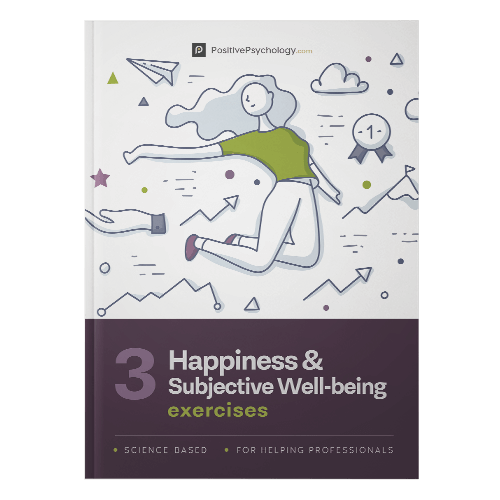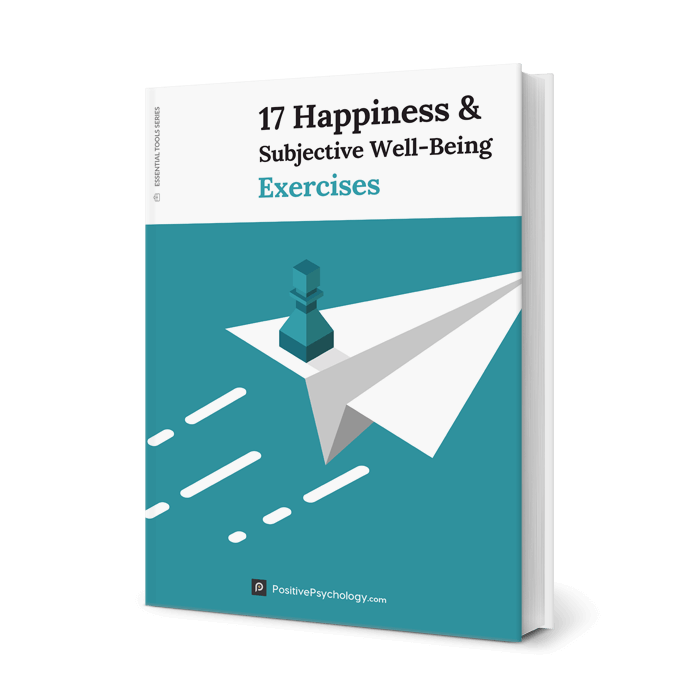Pollyanna Principle: The Psychology of Positivity Bias
 When you think of “bias” you probably think of it in terms of something negative.
When you think of “bias” you probably think of it in terms of something negative.
For example, you might think of being biased against a group of people and link it to racism, or you may think of the theory of confirmation bias, which states that we often ignore all the evidence that doesn’t support our preferred way of thinking.
It’s true that bias is generally a bad thing since it involves having preconceived notions about things that may turn out to be false, unrealistic, or even harmful; however, a bias isn’t always a bad thing.
In fact, there is a bias that is deeply rooted and pervasive throughout all cultures and all people, and it helps us to be happier, healthier, and more connected with others. It’s called the positivity bias, or the “Pollyanna Principle.”
Before you continue, we thought you might like to download our three Happiness & Subjective Wellbeing Exercises for free. These detailed, science-based exercises will help you or your clients identify sources of authentic happiness and strategies to boost wellbeing.
This Article Contains:
What is the Pollyanna Principle?
The term “Pollyanna Principle” refers to the human tendency to focus on the positive and use more positive words and terms during a conversation. Generally, people who are mentally healthy and not suffering from depression tend to focus more on the positive than the negative, and they are prone to recalling more positive than negative phenomena from their memories as well.
According to researchers Dember and Penwell (1980), there are many ways this positivity bias manifests:
“…people’s overestimating the size of valued objects, avoiding looking at unpleasant pictures, communicating good news more frequently than bad, and so on.”
(p. 321)
Although some of us think of ourselves as pessimists or realists, either thinking more about what goes wrong than what goes right or trying to strike a healthy balance, we are still generally a pretty positive-focused species.
Doctor Clay Jones puts it this way: “Anyone who isn’t clinically depressed is on some level more like Pollyanna than Eeyore” (2014). We may not think we’re very positive, but it is written in our very DNA to look on the bright side—we all have a built-in capacity for positivity, but whether we actually embrace the Pollyanna Principle and set our sights on the positive or succumb to negativity is almost entirely up to us.
Origin of the Term Pollyanna Principle
You might be wondering where the term “Pollyanna Principle” came from. In fact, this is a case of life imitating art—it was named after the titular character from author Eleanor Porter’s children’s book Pollyanna, a cheerful and optimistic girl who always looks on the bright side.
Pollyanna played what she called the “Glad Game,” and what we might think of as practicing gratitude today. In every situation, no matter how sad or upsetting, Pollyanna tried to find at least one good thing—a “silver lining” as we often call it today. She’s so good at this game that she ends up getting her whole town to play along, and she makes a significant positive impact on the people of her town (Jones, 2014).
The Psychology of Pollyannaism
This principle was first identified by researchers Matlin and Stang in the 1970s, who observed that humans tend to be noticeably upbeat and positive more often than downcast and surly. Their research found that people place greater importance on the positive, and often assume the best when it comes to making decisions without all the relevant information.
In their own words, Matlin and Stang explained, “cognitive processes selectively favor processing of pleasant over unpleasant information” (1978, p. 4). This tendency leads us to be more optimistic, positive, and forward-thinking, all traits that help us to function in our everyday lives and smooths our interactions with other people (more on that later).
In addition to focusing on the positive overall, the Pollyanna Principle explains that we are much more likely to remember pleasant and positive memories. We even tend to recall neutral events as more positive than they really were, which often gives us “rose-colored glasses” about our past and feeds our sense of nostalgia for days gone by.
Although the tendency to be optimistic and find the silver lining is no doubt a desirable trait—and one that imparts benefits to our health and well-being to boot—to be a “Pollyanna” is generally not considered to be a good thing. In fact, if you type “Pollyanna” into Google, you get this definition:
“An excessively cheerful or optimistic person” (emphasis added).
That word—excessive—explains the general resistance to adopting Pollyanna’s cheerful attitude; there is such a thing as being too cheerful and optimistic. Consider an example from your own life—there is likely at least one or two occasions in which you needed to vent or complain a bit, and an irritatingly optimistic person either prevented you from doing so or made you feel bad for thinking negatively.
We all have our down days and difficult moments, and none of us can be Pollyanna all the time. As with most things in life, the sweet spot is in a healthy balance of positivity and optimism along with realism, a sense of context, and a working understanding of what is appropriate and when.
As it turns out, even those of us who suffer from depression or other mood disorders have an inherent ability to focus on the positive. Psychologists William Dember and Larry Penwell conducted an experiment in which they compared scores on the Beck Depression Inventory (a widely-used scale for depressive symptoms) with scores on a happiness measure and two “Pollyanna” measures.
Dember and Penwell found that, as expected, scores on the depression measure were significantly negatively correlated to scores on the happiness measure, but depression scores were not significantly correlated with the scores on either Pollyanna measure (1980).
This indicates that our inherent positivity bias is something separate from the mood disorders that afflict so many of us, and suggests that we are still capable of focusing on the positive even in the most trying and depressing times.
Perhaps this innate tendency towards the positive is what the many treatments for depression are able to harness and reinforce, guiding us to use our own inner strength to restore a healthy balance of positivity and realism instead of falling on the negative side of the spectrum.
What is the Person-Positivity Bias?

The need for a balance of optimism and realism is highlighted when we consider how our feelings about people influence our behavior.
If we always assumed the best of people and focused only on the positive, we would find ourselves being taken advantage of and may end up penniless and downtrodden!
Although we do have our likes and dislikes when it comes to people we know, the positivity bias extends to this domain as well—we tend to think positively about individual people unless given reason to think otherwise.
Although related to the Pollyanna Principle, this phenomenon has its own term: person-positivity bias. It is based on the observation that people tend to like individuals more than the groups that the very same individuals compose (Sears, 1983).
You might recognize this in some of your daily conversations—have you ever heard someone say something like, “I generally don’t like Red Sox fans, but you’re alright!” or “I hate lawyers, but this one’s not so bad.”
This tendency to see the positive in individual people causes us to make “exceptions” and—generally—to continue with our established view of the group or groups to which they belong. For example, this phenomenon helps explain why racist people can have a friend who is a member of a racial minority but still see that race as inferior or undesirable overall.
One interesting bit of evidence that points to the existence of a person-positivity bias is the phenomenon of student evaluations: students generally rate their professors significantly more highly than the very classes they teach!
Further, the president of the United States is usually more well-liked than the Congress as a whole, but individual members of Congress are usually more well-liked than Congress as a group (“Person-positivity heuristic”, n.d.).
The person-positivity bias is a strong one, and succinctly explains how Congress can have such low approval ratings (around 10% in recent times) but individual members of Congress can have such high ratings, although it’s important to note that these ratings will largely vary by party affiliation.
On the subject of party affiliation, that brings us to another great example of the person-positivity bias; politics have become more polarizing than ever, with extreme groups on every edge and around all the fringes of any spectrum of political opinions. However, although there are many people with extremely strong, negative opinions about all members of the opposing party, we all still tend to get along pretty well on a daily basis.
This is because, while people may have very rigid views on the other party (e.g., “All conservatives are selfish” or “All liberals are overly sensitive”), they tend to make exceptions for the people in their life who belong to that party.
Very few families are composed entirely of people who have the exact same views on politics, so it’s often necessary to interact with at least a few people of the “undesirable” group in a polite manner. When these interactions remain civil and family ties bind people together, it’s easy to start making exceptions for those with differing views and seeing them as “one of the (few) good ones.”
Our positive perceptions of individual people have been an evolutionary advantage for millennia, helping us to get along and work together to survive. Although it is arguably less important to band together for survival in modern times, the positive bias humans have for other people is still the glue that holds society together and helps bond us to one another.
Research on Positivity Bias
You might be wondering how we know that this general positivity bias exists. What evidence is there to back up this theory of the prominence of a humanity-wide focus on the positive? Research in many different areas and from several different perspectives have found evidence of the positivity bias, but two core threads of research shed light on the phenomenon: language and aging.
Positivity Bias and Language
One of the ways in which researchers have been able to highlight the existence of the Pollyanna Principle is through analyzing the language we use. A recent study that evaluated over 100,000 words across 10 different languages found that there is a universal and deep-rooted positivity bias that crosses the boundaries of country, language, culture, and even frequency of word use (or how much we tend to talk; Dodds et al., 2015).
Data was collected from Twitter, Google, Google Books, the New York Times, movie and TV subtitles, and music lyrics, and the languages evaluated included English, Spanish, Portuguese French, German, Russian, Arabic, Indonesian, Korean, and Chinese. In every single sample, the researchers found evidence of a positivity bias—although some languages and sources were more prone to positivity than others (Dodds et al., 2015).
The findings from this substantial undertaking highlight what has been theorized and postulated by psychologists since the 1970s: that humans have a natural tendency towards “Pollyannaism.”
Positivity Bias and Aging
This positivity bias that encourages us to pay attention to the positive in life is generally stronger in older adults than in children and young people. Many studies have found that, as people age, they tend to remember more positive than negative information (Reed & Carstensen, 2012).
Some researchers have hypothesized that the positivity bias is due to cognitive decline, but others insist that the positivity bias is present in cognitively healthy older adults and results from one’s ability to shift mental effort to goal-relevant stimuli and away from distractions or non-relevant stimuli (Reed & Carstensen, 2012).
Whether this bias is caused by healthy cognitive processing or dysfunctional cognition, it’s clear that older adults are more likely to focus on the positive in their lives. For example, older adults have been shown to recall a greater proportion of positive images than negative images as compared to younger people (Mather & Knight, 2005), they direct their attention towards happy faces and away from angry or sad faces (Isaacowitz et al., 2006), and they focus on the positive attributes or consequences of their choices more frequently than younger people (Mather et al., 2005).
Perhaps this turn towards the positive in older adults is due to the wisdom that only age can bring; they have learned to use their attention wisely instead of wasting it worrying and fretting about the negative side of life. Whatever the explanation, older adults seem to be perfectly suited to giving advice and helping younger people focus on the positive—so make sure to listen when your parents and grandparents share their words of wisdom!
However, don’t fall into the trap of being too positive.
The Lake Wobegon Effect
You may have heard of something similar to the Pollyanna Principle called the “Lake Wobegon Effect.” This effect comes from Garrison Keillor’s utopian town of Lake Wobegon, where “all the women are strong, all the men are good-looking, and all the children above average” (Keillor, as cited in White, 2012).
It also describes the tendency to filter out the negative and focus on the positive, but in one specific area: when it comes to yourself! Many of us tend to overestimate our strengths, talents, and capabilities and see ourselves as better than others in one way or another (White, 2012).
In psychology, this is known by a more precise name: the self-enhancement bias. It exists in all domains and facets of life, causing us to think we’re more hard-working, funnier, more attractive, better drivers, more skilled, and more honest than the people around us.
Although a good sense of self-esteem and self-love is healthy, some people take the Lake Wobegon effect to the extreme. As you can imagine, a strong self-enhancement bias is not very effective at winning you friends or giving you a realistic perspective on the world. Researchers have found that this effect is more prominent in certain cultures than others; you may think the greatest divide is between individualistic and collectivistic cultures, but recent research has suggested that self-enhancement bias is strongest in nations with high economic inequality (White, 2012).
The Lake Wobegon effect highlights the advantages and potential disadvantages of focusing solely on the positive—it’s great to be optimistic and forward-thinking, but it actually is possible to have too much positivity and too much self-esteem.
Examples of a Positivity Bias
There are tons of examples of a positivity bias that you might recognize, such as:
- When remembering the first date with your spouse, you think about the excitement and how well you got along rather than how nervous you were or how awkward the conversation was at times.
- You search for something on Google and quickly scan through the resulting images, noticing the positive and happy images more often than the negative images.
- Unless you are going through a particularly challenging time, your text messages, social media posts, and emails to friends and family have more positive words and references than negative ones.
- When looking through a list of words or playing word-related games or puzzles (like Scrabble, crossword puzzles, and word searches), you tend to think of and notice positive words more often than negative ones.
- When you think back on your day, your memory probably focuses on the good things that happened, like getting a sweet message from your significant other, receiving good news on a project at work, or eating a particularly good meal.
- If someone asks you to describe yourself, you likely start off with positive attributes (e.g., caring, funny, good listener, responsible).
- Similarly, if someone asks you to describe your spouse or significant other, you probably rattle off a list of positive attributes here as well—provided that you’re not in the middle of an argument!
- If you think back on a childhood experience like going off to summer camp, you will find your positive memories of swimming, hiking, and playing games more salient than the negative memories like feeling homesick and getting covered in bug bites.
When you stop to think about it, we really are quite a positive species! Barring the bad days that we all have now and then—and the outliers who tend towards pessimism on a more permanent basis—we are pretty good at keeping our minds on the positive.
5 Recommended Videos
If you’d like to learn more about Pollyanna and her “Glad Game,” check out this clip of the movie “Pollyanna” from 1960, which shows how she sticks to her positivity in the face of adversity.
To learn more about the Pollyanna Principles from a more academic perspective, you may find these videos helpful:
Is life inherently horrible? David Benatar and the Pollyanna Principle from Carneades.org
The Pollyanna Hypothesis – Epic Science #108 – How Stuff Works
Introducing the Pollyanna Principles – Hildy Gottlieb and Creating the Future
How language shows we’re biased toward positivity – CBS This Morning
A Take-Home Message
In this short piece, we covered the “Pollyanna Principle” and described the human tendency to focus on the positive. The take-home message here is that we are actually programmed to notice the good in life and pay attention to the positive, which ties in nicely with the recent rise of positive psychology.
If you struggle with thinking positively and staying optimistic, use this piece and your knowledge of the Pollyanna Principle to remind yourself that you’re much more good at focusing on the positive than you might think. Take comfort in the fact that you are already quite capable of looking on the bright side; sometimes you just need a little nudge to embrace it!
What are your thoughts on the Pollyanna Principle? Do you find that it applies to your own life? Do you ever get tired of an overly positive and upbeat “Pollyanna” in your life? Let us know in the comments!
Thanks for reading, and best of luck in cultivating your capacity to find the silver lining in whatever situation you are in!
We hope you enjoyed reading this article. Don’t forget to download our three Happiness Exercises for free.
- Dember, W. N., & Penwell, L. (1980). Happiness, depression, and the Pollyanna principle. Bulletin of the Psychonomic Society, 15(5), 321-323.
- Dodds, P. S., Clark, E. M., Desu, S., Frank, M. R., Reagan, A. J., Williams, J. R., Mitchell, L., … & Danforth, C. M. (2015). Human language reveals a universal positivity bias. Proceedings of the National Academy of Sciences USA, 112, 2389-2394.
- Isaacowitz, D. M., Wadlinger, H. A., Goren, D., & Wilson, H. R. (2006). Selective preference in visual fixation away from negative images in old age? An eye-tracking study. Psychology and Aging, 21, 40-48.
- Jones, C. (2014). The Pollyanna phenomenon and non-inferiority: How our experience (and research) can lead to poor treatment choices. Science-Based Medicine. Retrieved from https://sciencebasedmedicine.org/the-pollyanna-phenomenon-and-non-inferiority-how-our-experience-and-research-can-lead-to-poor-treatment-choices/
- Mather, M., & Knight, M. R. (2006). Angry faces get noticed quickly: Threat detection is not impaired among older adults. The Journals of Gerontology, Series B: Psychological Sciences and Social Sciences, 61B, 54-57.
- Mather, J. A., Larkin, G. R., Reuter-Lorenz, P. A., Carstensen, L. L. (2005). Divergent trajectories in the aging mind: Changes in working memory for affective versus visual information with age. Psychology and Aging, 20, 542-553.
- Matlin, M. W., & Stang, D. J. (1978). The Pollyanna Principle: Selectivity in language, memory, and thought. Cambridge, MA, US: Schenkman.
- “Person-positivity heuristic.” (n.d.). Research Net: Psychology. Retrieved from https://psychology.iresearchnet.com/social-psychology/social-cognition/person-positivity-heuristic/
- Reed, A. E., & Carstensen, L. L. (2012). The theory behind the age-related positivity effect. Frontiers in Psychology, 2012, 339.
- Sears, D. O. (1983). The person-positivity bias. Journal of Personality and Social Psychology, 44, 233-250.
- White, L. T. (2012). Occupy Lake Wobegon. Psychology Today. Retrieved from https://www.psycholog ytoday.com/us/blog/culture-conscious/201205/occupy-lake-wobegon
Let us know your thoughts
Read other articles by their category
- Body & Brain (49)
- Coaching & Application (57)
- Compassion (26)
- Counseling (51)
- Emotional Intelligence (24)
- Gratitude (18)
- Grief & Bereavement (21)
- Happiness & SWB (40)
- Meaning & Values (26)
- Meditation (20)
- Mindfulness (45)
- Motivation & Goals (45)
- Optimism & Mindset (34)
- Positive CBT (28)
- Positive Communication (20)
- Positive Education (47)
- Positive Emotions (32)
- Positive Leadership (18)
- Positive Parenting (4)
- Positive Psychology (33)
- Positive Workplace (37)
- Productivity (16)
- Relationships (46)
- Resilience & Coping (36)
- Self Awareness (21)
- Self Esteem (38)
- Strengths & Virtues (32)
- Stress & Burnout Prevention (34)
- Theory & Books (46)
- Therapy Exercises (37)
- Types of Therapy (64)





What our readers think
Hello I am a bit dumbfounded. Towards the end u list a couple of things and for example u said u remember how it’s bad to think of the good. That when remembering ur first date u only remember the good and not the bad. I don’t see how remembering the good only is a bad thing. Actually I guess I answered my own question you were just saying it’s just overall pretty bad to JUST remember the good. I think it’s good actually I know it’s good to remember the good and bad. I think one thing you could have emphasized it to think of the bad sometimes. But this is positive psychology so I can see why u didn’t!